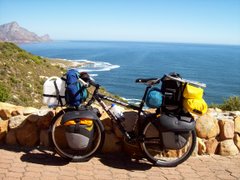




A long time ago (when I was a teenager) a slang term for "girlfriend" was "Goose". Well, in less than 3 weeks now I've chased across India from Kolkata to Mangalore for 2400 km to catch up with Leana and her sister Amanda. These 2 have been cycling down the West coast from Mumbai since Leana's recovery from injury, Amanda joining in for a 2-month cycling "holiday". I may have been getting lonely or something, so I decided to try and catch up with Leana before Christmas. The chase was complicated by a mysterious illness which delayed my departure from Kolkata and hampered my progress for the next week or so (painkillers and anti-nausea medicine kept me going). At one stage I also had to replace the front wheel hub on my bike (fortunately I've been carrying a spare), a tricky enough task made somewhat more challenging by spectators all keen to become involved. Broken spokes and continuous punctures due to expired spare tubes added a measure of variation to the long days spent on the bike. One advantage of travelling by bicycle is that my route took me through areas where foreign tourists are seldom seen, and I've been endlessly photographed and "interviewed", and I've given numerous autographs to people who would otherwise not have known my name. I've spent nights in many dew-covered fields, cheap rooms, and even on verandah's of vacant village buildings. One of the most interesting things along the route was the numerous Hindu temples and statues of the Gods, and I was also surprised to see an extra-ordinary Catholic church amongs these (photo). In many of the areas through which I cycled the rice harvest was coming to an end, and it was interesting to see the range of technology used to transport the grain from the field to the threshing floor (see photo of labourers carrying rice attached to bamboo poles). The last day of the chase was down a winding mountain road of which the surface had completely disintegrated due to recent rains and the churning of many truck tyres. I must have looked a sorry sight covered in dust and sweat when I arrived at my destination, but the nice room and welcoming drink soon made the previous 3 weeks seem like a vague dream. Now, after a rest and having scrubbed everything from the soles of my shoes to the top of my cycling helmet, I feel like a new person (of course, I was also very pleased to see Leana again after nearly 2 and a half months apart). I'm looking forward to a more relaxing time, at least for the next few weeks. My bike, Old Saartjie, is the one now in desparate need of some serious attention. Daily distances cycled since Kolkata have been:- Karagpur 142 km; Baleshwar 117 km; Panikoli 108 km; Khorda 158 km; Balugaon 48 km; Gopalpur 77 km; Narassanapeta 137 km; Visakhapatnam 147 km; Annavaram 139 km; Siddanthan 116 km; Bapularadu 122 km; Guntur 130 km; Kavali 135 km; Naidupet 129 km; Chittoor 139 km; Kolar 118 km; Kunigal 116 km; Channatayapatna 102 km; Sakleshpur 93 km; and Mangalore 119 km. Total since start of this journey in Cape Town is 32 997 km. Merry Xmas everyone!






















































